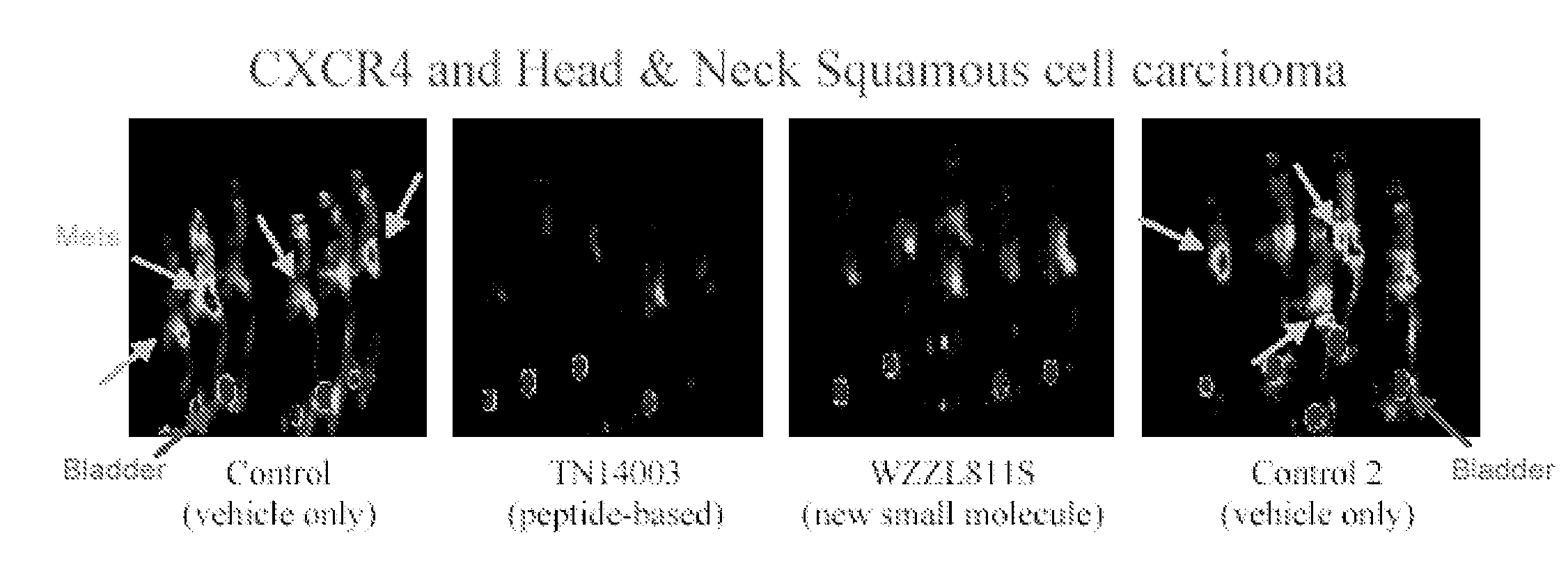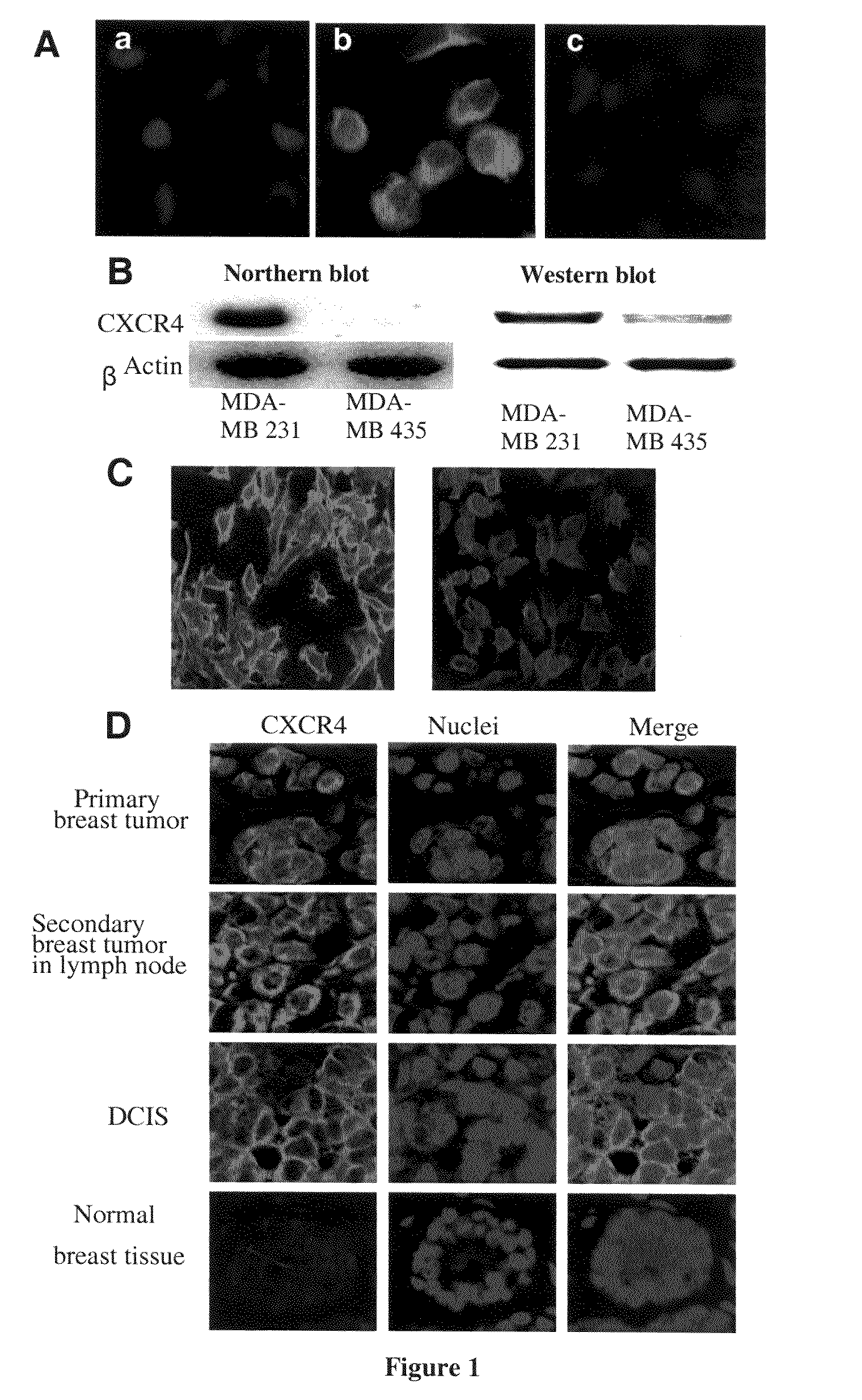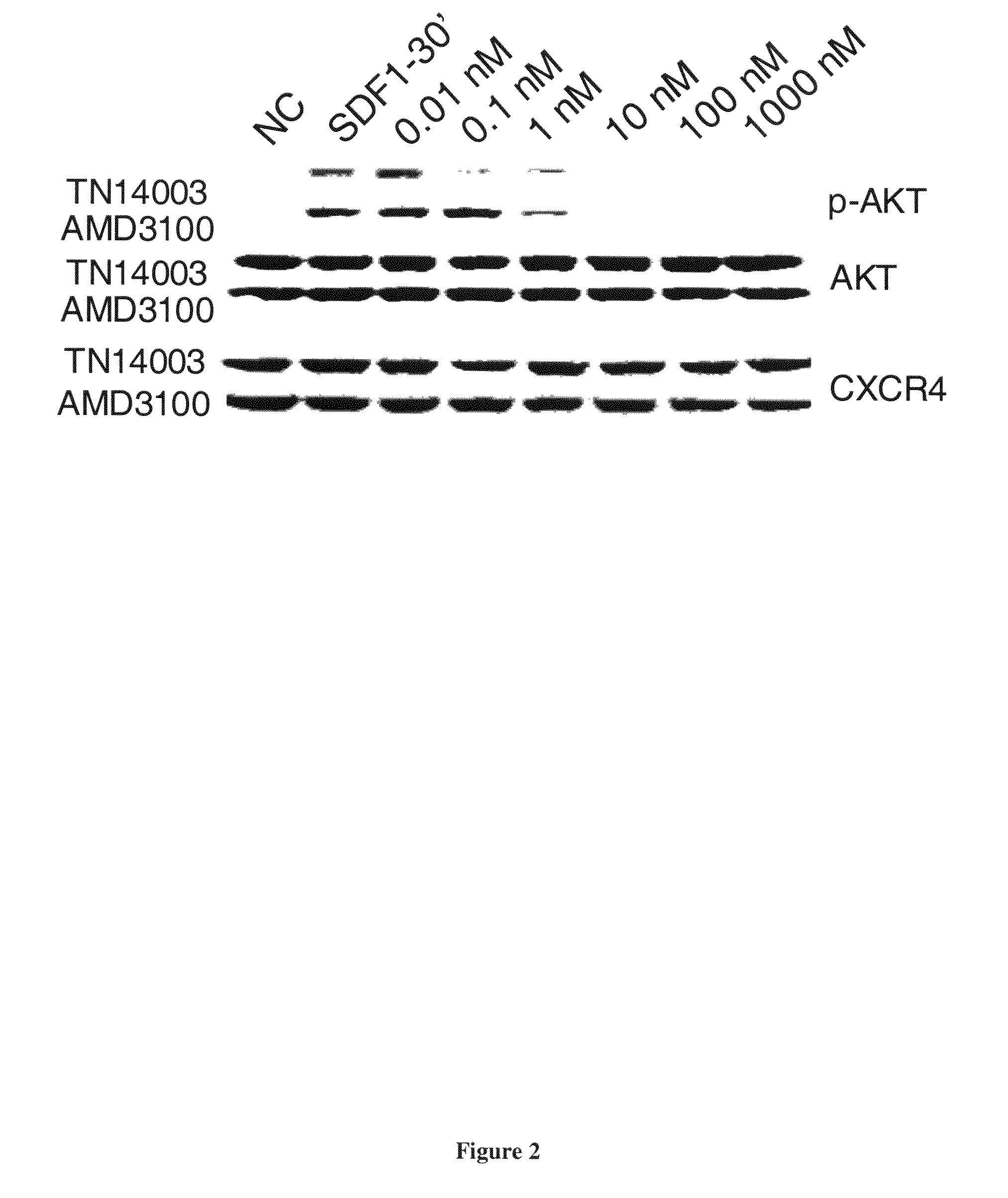CXCR4 Antagonists Including Diazine And Triazine Structures For The Treatment Of Medical Disorders
a technology of cxcr4 and diazine, which is applied in the direction of biocide, organic chemistry, drug compositions, etc., can solve the problems of interfering with the binding of the cxcr4 receptor on the virus, and achieve the effects of preventing the metastasis of a malignant cell, and reducing the likelihood of recurren
- Summary
- Abstract
- Description
- Claims
- Application Information
AI Technical Summary
Benefits of technology
Problems solved by technology
Method used
Image
Examples
example 1
Peptide-Based CXCR4 Antagonist, TN14003, is a Novel-Imaging Probe Specific for CXCR4
[0252]Initially, experiments were performed to verify that TN14003 binds to the predicted SDF-1 binding sites on the CXCR4 receptor. In these studies, MDA-MB-231 cells were incubated in the absence (FIG. 1A, B) or presence (FIG. 1A, C) of 400 ng / ml of SDF-1α for 10 min, and then fixed in ice-cold acetone. Immunofluorescence of the biotin-labeled TN14003 was negative in both membrane and cytosol in the cells pretreated with SDF-1α for 10 min (FIG. 1A, C).
[0253]The utility of the biotinylated TN14003 as a probe of CXCR4 was explored coupled with immunofluorescence staining of cultured breast cancer cells and paraffin-embedded tissues from breast cancer patients. MDA-MB-231 had high levels of mRNA and protein for CXCR4 as shown by Northern blots and Western blots relative to MDA-MB-435 (FIG. 1B). When the biotinylated TN14003 was used to stain the two cell types, the high CXCR4-expressing MDA-MD-231 cel...
example 2
TN14003 is a More Potent Inhibitor of CXCR4-Associated Signaling than AMD3100
[0255]CXCR4 / SDF-1 interaction activates PI3K / Akt and Ras / Raf / MELK / Erk pathways in a Gαi protein (PTX-sensitive)-dependent manner. Experiments were conducted to determine the effect of blocking CXCR4 / SDF-1 interaction by either TN14003 or AMD3100 at different concentrations (0, 0.01, 0.1, 1, 10, 100, 1000nM) on phosphorylations of Akt and Erk1 / 2 signaling. Incubating cells with 100 ng / ml of SDF-1 for 30 minutes activated Akt. Akt activation was blocked by either sub-nano molar concentration of TN14003 or a few nano molar AMD3100 (FIG. 2). Erk1 / 2 phsophorylation was attenuated in the presence of sub-nano molar concentration of TN14003 or 100 nM AMD3100 (data not shown). However, the increase in Erk1 / 2 phosphorylation by SDF-1 was not significant as the increase in Akt phosphorylation. The results demonstrate that TN14003 is more potent than AMD3100 in inhibiting CXCR4-mediated signaling. Treating cells with S...
example 3
Knock Down of CXCR4 by siRNA Blocks Metstasis in the Lung
[0256]RNA interference technology, silencing targeted genes in mammalian cells, has become a powerful tool for studying gene function. Two different siRNA duplexes of CXCR4 (Genbank Accession no. NM—003467), siRNA1(sense, 5′-UAAAAUCUUCCUGCCCACCdTdT-3′) and siRNA2 (sense, 5′-GGAAGCUGUUGGCUGAAAAdTdT-3′) were designed and purchased from Dharmacon (Lafayette, Colo.). The non-specific control siRNA duplexes were purchased from Dhamacon with the same GC content as CXCR4 siRNAs (42%, D001206-10).
[0257]Lowering CXCR4 mRNA levels by siRNAs inhibited CXCR4 / SDF-1-mediated invasion as measured by a matrigel invasion assay. The CXCR4 ligand, SDF-1 (400 ng / ml) was added to the lower chamber to attract CXCR4-positive breast cancer cells to migrate through the matrigel. The invasion of MDA-MB-231 cells transfected with siRNA1 decreased to 39±4% of the control cells, 51±8% with siRNA2, and only 16±6% with both siRNA1+2 (FIG. 3A). FIG. 3B shows...
PUM
| Property | Measurement | Unit |
|---|---|---|
| temperatures | aaaaa | aaaaa |
| temperature | aaaaa | aaaaa |
| time | aaaaa | aaaaa |
Abstract
Description
Claims
Application Information
 Login to View More
Login to View More - R&D
- Intellectual Property
- Life Sciences
- Materials
- Tech Scout
- Unparalleled Data Quality
- Higher Quality Content
- 60% Fewer Hallucinations
Browse by: Latest US Patents, China's latest patents, Technical Efficacy Thesaurus, Application Domain, Technology Topic, Popular Technical Reports.
© 2025 PatSnap. All rights reserved.Legal|Privacy policy|Modern Slavery Act Transparency Statement|Sitemap|About US| Contact US: help@patsnap.com



